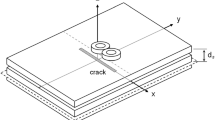Abstract
The problem of detection and characterization of a flaw in a conducting half-space using an eddy-current coil oriented parallel to the interface is examined. An expression is derived for a first order approximation for the change in complex impedance due to a flaw located within the conducting medium. The overall impedance is a function of the radius and lift-off distance of the test coil and the conductivity of the material. An analytical expression is derived for the change in impedance as a function of the electric fields at the position of the flaw. It is found to be an integral over the volume of the flaw of the electric fields found with and without the flaw being present. The limiting case of a degenerate point flaw may be examined in greater detail by allowing the field in the presence of the flaw to be approximated by the unperturbed field. For flaws small enough that the field does not vary much over its volume, the field may be even further approximated by using just the value of the field at the position of the centroid of the flaw. Plots are shown to illustrate the behavior of the change in impedance as a function of the radial range of the flaw and the depth of the flaw centroid, using previously derived expressions for the fields for the unflawed case.
Similar content being viewed by others
References
A. J. M. Zaman, S. A. Long, and C. G. Gardner, The impedance of a single-turn coil near a conducting half space,J. Nondestr. Eval. 1:183–189 (1980).
A. Bahr, Microwave eddy current techniques for quantitative nondestructive evaluation, inEddy Current Characterization of Materials and Structures, G. Birnbaum and G. Free, eds., (ASTM, Philadelphia, 1981), pp. 311–331.
B. A. Auld, Theoretical characterization and comparison of resonant probe microwave eddy-current methods, inEddy Current Characterization of Materials and Structures, G. Birnbaum and G. Free, eds., (ASTM, Philadelphia, 1981), pp. 332–347.
B. A. Auld, F. Muennemann, and D. K. Winslow, Eddy current probe response to open and closed surface flaws,J. Nondestr. Eval. 2:1–21 (1981).
A. J. M. Zaman, C. G. Gardner, and S. A. Long, Impedance of a loop surrounding a conducting cylinder,IEEE Trans. Instrumentation and Measurement, IM-30:41–45 (1981).
M. L. Burrows, A theory of eddy current flaw detection, Ph.D. dissertation, University of Michigan, Ann Arbor, 1964.
A. Erdelyi et al.,Tables of Integral Transform (McGraw-Hill, New York, 1954), Vol. 1, p. 183.
M. Abramowitz and I. Stegun,Handbook of Mathematical Functions, 9th ed. (Dover, New York, 1970), pp. 334–337.
Author information
Authors and Affiliations
Rights and permissions
About this article
Cite this article
Zaman, A.J.M., Gardner, C.G. & Long, S.A. Change in impedance of a single-turn coil due to a flaw in a conducting half space. J Nondestruct Eval 3, 37–43 (1982). https://doi.org/10.1007/BF00566953
Received:
Revised:
Issue Date:
DOI: https://doi.org/10.1007/BF00566953




